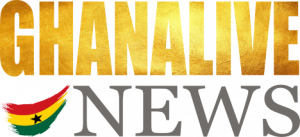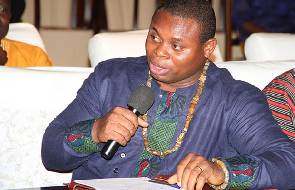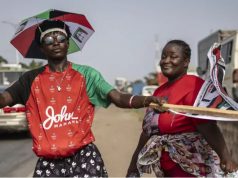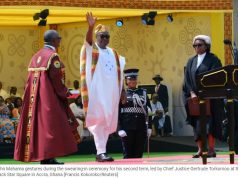Yesterday, Ghana’s Finance Minister, Mr. Ken Ofori- Atta presented his maiden budget to Parliament. The minister christened his budget ‘’ Asempa Budget’’ in the Twi language, loosely translated as ‘’Good news Budget’’. The general feeling is that the Minister passed his first test given the replication of major campaign promises in the budget. The structure of the budget itself didn’t change much from the previous and the minister and his economic team employed great skill not to stray significantly from economic targets set by the previous government at least for the 2016 fiscal year. IMANI people however picked up the following. We shall in due course present detailed analysis showing the impact of the budget on critical sectors of the economy.
A. Economy
The 2017 budget promises a budget deficit of 6.5% amidst significant tax cuts and a volatile commodity market. Total revenue on the other hand is expected to increase significantly this year to GHC44.9 billion from the 2016 outturn of GHc 33.67 billion. Out of this projected total revenue, GHC34.38 billion (The 2017 budget projects an increase of 47.7%, 13.3% and 36.3% in taxes on income and property, domestic goods and services and on international trade respectively amidst the tax cuts), representing 78% of proceeds expected to come from tax revenue. This is 2% higher than the 2016 percentage of 76%. End of year inflation has also been increasing steadily; inflation rate of 15.2 was recorded in 2012 and gradually increased to a peak of 17.7 in 2015 before falling to 15.4 in 2016.
In 2016, the government projected total revenue of about GHc 37.88 billion and was able to raise GHc 33.67 billion which indicates an 11% deviation from target. The NPP government expects to improve on the 2016 outturn by 33.5% to GHc 44.9 billion with an economic structure that has not significantly changed. Non-oil GDP will grow at 4.6% but corresponding government tax revenues will increase by 33% year on year. This must be analogous to the finance minister’s recollection of Jesus’ miracle of feeding over 5000 people with five loaves and two fishes.
The proportion of interest payments to GDP between 2014 and 2016 has been more than 6% while Capex to GDP has been just above 5%. This has greatly affected the productive capacity of the economy and GDP levels. Expectations of increased allocations to Capex has not been met, as the 2017 budget estimates a trifling GHc 7.1 billion to Capex which reflects a reduction of 7.2% over 2016 figures and 3.5% of GDP. Interest payments to GDP has been projected to increase by 29.4% from GHc 10.77 billion to GHc 13.9 billion representing 6.9% of GDP. Moreover, the estimated 6.5% budget deficit for the 2017 budget is to be financed solely with domestic debt of GHc 14.5 billion which is 7.1% GDP.
2016 witnessed a decline in yields on government securities. This trend will be difficult to sustain as the expected increase in domestic debt may adversely affect the supply of loanable funds and interest rate which will in turn affect private sector growth. This could potentially counter the gains expected from the tax cut agenda. Moreover, the 2017 budget also highlights a number of tax cuts[1] which includes the scraping of VAT on Airline tickets and abolishing import tax on auto spare parts. Abolishing taxes on auto spare parts will only have a significant impact on the economy if the Cedi stabilizes.
Domestic borrowing looks set to be aggressive this year. The budget forecast indicates a GHc 14.5 billion domestic borrowing, which is about 10% higher than the budget deficit of GHc 13.17 billion. Thus government will be borrowing domestically to pay off foreign debt. The 91 day Treasury bill rate over past three months has fallen from 20.24% (as at 21st November, 2016) to 15.94% (as at 2nd March, 2017) yet DMBs are charging interest rates between 30% and 40%. How will this increased appetite for domestic debt affect interest rates and loanable funds?
B. Infrastructure
GHc 2.62 billion has been allocated to the infrastructure subsector. The budgeted figure covers the Ministry of Water Resources Works and Housing, Roads and Highways, Communication, Railway Development, Aviation and Transport. It is shocking to note that the Office of Government Machinery has been allocated an amount of GHc 1.56 billion, which accounts for 60% of the funds allocated to six sector ministries under infrastructure.
Railway Infrastructure
The management of rail infrastructure is an expensive endeavour. The deplorable state of our railway sector is a result of consistent neglect, low investment and lack of renovation culture. Historically, successive governments have not demonstrated competence in managing state enterprises. Given this background, it would therefore be prudent for Government to focus on regulating the rail sector, handing over the management of the sector to a private entity that would ensure consistent investment in renovation works. The government is currently courting private sector players to invest in the Eastern, Central and Urban railways. A private sector management of the rail infrastructure would make the sector more attractive and less risky to other potential investors who will be assured of return on their investments. A total of GHc 320 million has been allocated to the Ministry of Railways, 33% (GH¢106 million) is donor funded, GHc32.8 million (10%) allocated for Goods and service and GHc 26.2 million (82%) to be spent on Capital expenditure.
It is however strange to note that with an expected staff ceiling of 22 for the Ministry, GHc24.2 million (8%) of the allocation will be spent on compensation, which is about the same amount allocated to the Ministry of Communication with a staff celling of 686.
The Western Line which begins from Takoradi and ends at Kumasi with two branch lines; Dunkwa to Awaso and Kojokrom to Sekondi, is the main project to be executed in 2017 by the Ministry. The brownfield project, which involves renovation of existing lines, covers a distance 340km. The project aims at providing a cheaper haulage service for manganese, bauxite, cocoa and other bulk commodities to the Takoradi port for export. If the estimated GH¢6.14 billioninvestment costs for rehabilitation, acquisition of rolling stock, signaling and buildings by the National Developing Planning Commission (NDPC) is anything to go by, the GH¢262.6 million CAPEX allocated to the sector for 2017 is a drop in the ocean.
The Eastern, Central corridor and Urban railway projects in Accra and Kumasi which are expected to be executed through PPP will most likely not be finalised in 2017.
The National Identification Scheme
The national identification scheme and the national digital address system are part of the special policy initiatives by the government to formalize the economy, broaden the tax base, in order to rake in more revenue to make up for the abolishment of several “nuisance” taxes. Additionally, other advantages of having an integrated National ID Database and Card system include a credible voter register, an improvement in the quality of data used for policy planning, countering cyber-crimes and many others make it a worthy venture to invest in.
It cost GHc21 million to undertake the mass registration process in 2010. GHc100 million have been budgeted for the scheme to register the remaining 12 million Ghanaians by the end of the year. Beyond the initial huge capital investment into the infrastructure and mass registration, a funding model is required for the maintenance and effective operations of the scheme. An estimated $10 million annual budget at 80% population penetration is required for operation expenses for the National ID database. It will be interesting to know the percentage of the allocations to CAPEX.
C. Education
The 2017 budget statement provided an estimation of government’s wildly popular Free Secondary Education programme and the upward review of the capitation grant by 100%. GHc 400 million ($100 million) was allocated for the implementation of Free SHS policy come September 2017. All the GHC 400million is allocated to Goods and Services, with GHC 188.2 million financed by Government and GHC 211.7 million by the Annual Budget Funding Amount.It is important to note that the success of the Free SHS policy is contingent on the availability of Goods, Services and Assets. The 2017 allocation is skewed toward Goods and Services casting doubt over the infrastructure (CAPEX) component of the policy. Government funds for Goods and Services in the education sector are beset with delays, with a 19.2% GoG budget execution rate in 2015.
The Budget Statement is silent on the expected number of students the policy will cover come September 2017, but it is emphatic the coverage will be for first year students only and possibly for the first school term out of three.
In general, the total budget for the Ministry of Education, including the GETFUND, saw an increase of 20.7% in 2016, when the budget was GHc 7.55 billion, whilst in 2017 the designated spending is GHC 9.12 billion. Curiously, with no allocation in 2016 from the ABFA, ABFA allocation to education this year will be the highest in the last five years. Infrastructure delivery in the education sector has been dependent on ABFA and GETFUND, given the decline in donor funds over the past five years. With ABFA being dispensed to finance Goods and Services, we have no idea what the prospect of infrastructure delivery will be for the sector.
D. Health
The restoration of the nurses’ trainee allowances is budgeted to cost GHC 149 million. The budget doesn’t indicate how many nurses will receive the allowance or the amount of allowance per student per month. Using an estimate of GHC400 per student per month[2], the GHc149 million would cover the allowances of 31,000 students only. Conservative estimates suggest there are about 40,000 nursing training students across the 21 public nursing training colleges. With this number of nursing students, the allowance per student within this budget would be GHC 314. This suggests that either the allowance per student will have to be lower than the expected GHC 400, or the government will need to reintroduce a limit to the number of students allowed onto nursing courses. A cap on enrolment may in the future, reduce the number of nurses serving the population, which would counter the priority of the government to recruit more health staff.
The expenditure on the nursing trainee allowances constitutes 41% of the GHc 350 million total Goods and Services budget for the Ministry of Health, all of which is being funded by the Government of Ghana (GoG). This is almost ten times the amount spent on Goods & Services for the Ministry in 2016, which was about GHC3.6million. This hefty increase indicates a growth in the inventory of goods and services for the provision of healthcare. However, this type of expenditure isn’t explicitly stated in the budget.
E. Ancillary Discoveries for the Social Sector
When analysing the costs of staff in the eight ministries in the Social Sector, an interesting trend emerges. The MDA in the social sector with the lowest cost per staff is the Ministry of Employment and Labour Relations, where the 2,217 staff will each receive an average of GHC 15,602.93 per year. This can be compared to the National Labour Commission, which has the highest average cost per staff of GHC 32,939.41 per year. This is more than double the average amount per staff per year for the Ministry of Employment and labour Relations. The Ministry of Chieftaincy and Religious Affairs has the second highest amount in the social sector, with staff costing an average of GHC 32,177.65 per year. This is higher than both the Ministry of Education and the Ministry of Health, which employ the largest amount of people but have average staff costs of GHC 18,384.51 and GHC 20,419.70 per year.
F. Energy
Total budget allocation by the new government to the Ministry of Energy (power and petroleum subsumed) increased by 464% from Gh157.7 million in 2015 to Gh889.7 million in 2017. Out of these allocations, the amount spent on capital expenditure declined by 23% over the same period even though 11.24% of the 2017 allocation to the ministry of energy has been allocated towards capital expenditure. The amount allocated to employee compensation also declined by 49% over the period and that allocated to expenditure on goods and services also declined by 84%. There was no allocation to capital expenditure in 2016 by the previous government.
Apparent throughout the budget statement are the initiatives to be adopted by the new government to deal with the issues of legacy debts of the power utilities which currently stands at USD$2.4bn. Previous debt restructuring efforts have been undertaken without a clear strategy to limit further accumulation of debt by the power utilities. Prudent allocation of the energy sector levy towards debt payment is key coupled with the implementation of a credit risk assessment framework to guide borrowing of SOE’s in the power sector. So far, the government reports that Ghc3.3 billion accrued from the imposition of the ESLA by year end 2016 against an expectation of GHc3.26 billion. The revenue target was exceeded by 1.3% and this was attributed to a balance of GHc83.27million brought forward from existing energy-related accounts as well as a marginal over-performance in Energy Debt Recovery Levy collections over the period.
Once again we see an impetus towards increases in generation capacity, as was seen in previous budgets, without clear policy initiatives to utilize excess generation capacity considering that an excess capacity of over 1000MW already exists. A total of 1227MW of installed capacity scheduled to be added include: 370MW AKSA project, 107MW GPGC project, 350MW CenPower Project and 400MW Early Power Project among others. All these increases in generation are thermal in nature which means requisite fuel to power generation which continues to be the major problem in the sector. There is an absence of corresponding strategies to resolve inconsistency of gas supply issues with WAGP. Have LNG contracts come to a head? Are we banking all our hopes on gas from the TEN and Sankofa fields? Are our sources of fuel to power these plants efficiently diversified? Is the government going to continue to spend hard earned dollars on importation of expensive LCO to feed these new thermal plants? There is a clear lack of a robust strategy to secure fuel for projected increases in thermal generation. Perhaps the unbundling of VRA by creating a separate thermal market which will be handled by a new private entity will effectively deal with the issue of excess generation capacity. One of the main causes of VRA’s indebtedness is that it supplies fuels to the IPP’s. Should unbundling lift this burden, it will go a long way to liberate VRA.
The excitement over the relatively stable oil price at USD$55/bbl, 28% higher than 2016 oil price, and increased oil production due to the coming on stream of the TEN field is abundantly clear from the 2017 budget. Petroleum revenue is projected to reach US$515.64 million in 2017, an increase of 148% above the 2016 revenue outturn.
What is more, the ABFA priority areas have been redefined to give more attention to agriculture, education and health which is a welcome relief. Considering previous budgets, total cumulative allocation to the ABFA between 2011 and 2015 stood at US$1,428.76m. Allocations from the ABFA to the agriculture modernization priority area after seeing a pronounced increase in 2014, began to dwindle till it reached approximately 5% of ABFA in 2015. Allocations to education and health have been predominantly subsumed under the “Road and Other Infrastructure” as well as the “Capacity Building” priority areas over the period and have received respectively an average of 6.125% and 0.3% of the ABFA under “other infrastructure”. These allocations to health and education from the ABFA have at best been scant.
Given the 2017 budget provisions, total ABFA is estimated at approximately US$360.78m (Gh1.6bn). Out of the total ABFA allocated to the “Physical Infrastructure and Service Delivery in Education”, an amount of GHc211.7 million has been allocated to the supply goods and services in lieu of the Free SHS initiative representing an effective 13.04% of the total ABFA. An allocation of GHc 50 million representing 3.08% of total ABFA has been allocated to fund capital expenditure in the health sector. For the agricultural sector, a total of GHc156.1 million has been allocated with GHc142.4 million to be spent on capital expenditure and GHc13.7 million to be spent on goods and services. Total allocation to agriculture represents 9.6% of total ABFA. It is safe to say that, the ABFA is being effectively leveraged to provide funding support to the free SHS initiative of the new government and exceeds GoG funding for free SHS which stands at GHc188.3 million. A noteworthy fact is that both expenditure sources for free SHS are channeled towards expenditure on goods and services and not on capital expenditure.
G. Governance
The whole rationale behind the setting up of an Office of The Special Prosecutor (OSP) is in two folds. Firstly, to ensure a focus on issues of public sector corruption, given that the Attorney General’s office is burdened with a wide range of matters. Secondly, to remove all hints of partisan considerations in the prosecution of corrupt public officials. In 2014, the Ministry of Justice and Attorney General was allocated GHc 64.5 million whilst in 2015 and in 2016 the allocations increased to GHc 62.6 million and GHc 74.7 million respectively. According to the 2017 budget, the Ministry of Justice and Attorney General has been allocated GHc75.2 million. The Office of the Special Prosecutor wasn’t given any indication of financial support in the 2017 budget. Perhaps this important office will be supported by our donor partners.
[1]. Tax cuts include: abolish the 1 percent Special Import Levy; abolish the 17.5 percent VAT/NHIL on financial services; abolish the 17.5 percent VAT/NHIL on selected imported medicines, that are not produced locally; initiate steps to remove import duties on raw materials and machinery for production within the context of the ECOWAS Common External Tariff (CET) Protocol; abolish the 17.5 percent VAT/NHIL on domestic airline tickets; abolish the 5 percent VAT/NHIL on Real Estate sales; abolish excise duty on petroleum; reduce special petroleum tax rate from 17.5 percent to 15 percent; abolish duty on the importation of spare parts; abolish levies imposed on ‘kayayei’ by local authorities; abolish levies imposed on religious institutions by local authorities; exempt from taxation, the gains from realization of securities listed on the Ghana Stock Exchange or publicly held securities approved by the Securities and Exchange Commission (SEC); reduce National Electrification Scheme Levy from 5 percent to 3 percent; reduce Public Lighting Levy from 5 percent to 2 percent; replace the 17.5 VAT/NHIL rate with a flat rate of 3 percent for traders; and implement tax credits and other incentives for businesses that hire young graduates.








